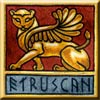
Nortia is the Etruscan Goddess of fate, who is similar to the Roman Goddess Fortuna. She was the patron Goddess of the Etruscan city of Velsna, rendered by the Romans as Volsinii, and called in some accounts Nyrtia or Nursia, after the Goddess. Velsna was considered the sacred or moral center of Etruria, and within the city was a sanctuary to the God Voltumnus that functioned as a meeting-place for the Etruscan federation, made up of the twelve main cities of Etruria. Velsna was famed for its wealth and culture, and centuries after the Romans destroyed it in the process of conquering the Etruscans, Pliny relates the rather silly story that the reason the Romans wanted Velsna so badly was so they could take its two thousand statues as booty. After the Romans destroyed it, they moved the population to what they called Volsinii Novi, at a site not far from the original city. Very few remains are left of the older Volsinii, and no one nowadays is even exactly sure where it was located. Nortia had a great temple in Velsna, where it was the custom to drive a nail into the wall at the new year to mark the ending or fixing of the old year. This custom persisted into Roman times, and was performed at the great Temple of Juno, Jupiter, and Minerva on the Capitoline Hill by driving a nail into the lintel over the door to Minerva's cella (temple chamber). Some have seen in this custom a relation between the Etruscan Menrfa (who would in time become the Minerva of the Romans) and Nortia, and thus call Menrfa a Goddess of fortune as well. The act of driving a nail is seen as symbolic of Fate, as it fixes whatever is being nailed to one spot and puts an end to motion; in the language of metaphor it is especially the motion of that which moves through time, whether the life of a human being or the linear progression of a year. On one of the many Etruscan engraved bronze mirrors that have come down to us is a representation of a Goddess of fate about to hammer a nail into a wall. Her name is given above Her as Athrpa, the Etruscanized version of Atropos, the Greek Fate who cuts the thread representing a person's life span. Beside Her are the men whose fate She is fixing: Meleacr (Meleager) and Atuns (Adonis), both of whom die in their prime. She has, like many Etruscan Goddesses, great wings from Her back that spread out behind all the other players in the scene, as if to indicate Her all-encompassing power or Her primacy. That the act of hammering a nail was seen as symbolically equivalent to cutting the thread of life by the Etruscans is shown by the use of the Fate's name; for it may well be a representation of Nortia instead, who has been labelled with the equivalent Greek name. Several inscriptions to Nortia have been preserved, and in one She is referred to in the plural as Magnae Deae Nortiae, "the Great Goddesses [who are named] Nortia". Generally Goddesses who were honored with the title Magna, Great, were the major or top Goddesses in their pantheons, such as Minerva or Juno: this title can be taken to indicate both Nortia's importance among the Etruscans of Velsna and Her identification with Minerva. The Romans preserved a saying, clavo trabali fixum, (roughly meaning "an immovable nail in a beam") and used it of things that were unalterably fixed by Fate. Alternate spellings: Nartia, Nurtia, Nursia. She was identified with Menrfa or Minerva as well as Athrpa (Atropos), one of the Fates; She is also equated with the Roman Goddesses Fortuna and Necessitas by some. |
|
|



